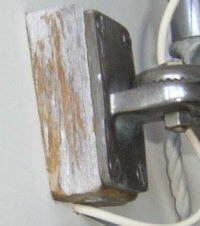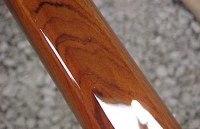If you have teak on your boat, there is only one really good solution to a finish – varnish. I’ve seen boats that let the teak weather. That may be fine for the die-hard sailor or the working waterman, but for a yacht it is a definite no-no! I’ve also seen boats that try to avoid varnish by using other products (such as Cetol). These product change the appearance of the teak giving it an almost “painted” look. Although easy to apply, they don’t hold up well and actually detract from the look of the boat.
 Above: some “nuisance teak” is often neglected due to the trouble it involves. Items such as this should be replaced with a material such as King Starboard.
Above: some “nuisance teak” is often neglected due to the trouble it involves. Items such as this should be replaced with a material such as King Starboard.
The key to a good varnish job is a perfect surface, ample build up of product and routine maintenance. If any of these are not right, the varnish will not hold up.
The foundation – the bare teak needs to be prepared properly. Any sanding imperfection will be magnified by the varnish. If the teak seems to be in good shape, you can probably get away with starting with 150 grit sandpaper and working up to 180 grit. This should smooth the surface enough, but still leave enough “bite” to hold the varnish.
The the first or “prime” coat should contain a fair amount of the proper thinner for the varnish you are using. This allows the varnish to wick into the pores of the wood and create a tight bond. The next couple of coats should contain less thinner until you reach a stage where you can start full strength build coats.
In the process of building, you will be sanding the surface smoother each time, so probably about 20% of the varnish you are applying is being removed on each coat. Eventually the surface will begin to get so smooth that you can drop down to 320 grit and take less off. The goal is to start with a minimum of eight coats of varnish.
After having your full build completed, the maintenance begins – in about 6 months. Ideally, you should be applying a full coat twice a year. If your varnish is covered or you keep your boat in a covered dock, you can probably get away with a coat every 14 months or so – but I wouldn’t recommend trying to push it any longer. It is tougher to fix varnish right than to perform the required maintenance.

And speaking of repairing varnish, it is an art to do this and make it look like it has not been repaired. The primary problem, once again, is our old friend the sun. The teak keeps lightening over time. When you sand down to bare teak and begin coating, the teak will be much darker than the rest of the teak on your boat. This will make the repair stick out like a sore thumb. The best approach is to strip to a point where there is a natural break in the teak. This would involve stripping a whole rail in lieu of the one foot of bad varnish, but the overall look will be worth the extra effort. There are some varnishes that don’t impart any color when applied, but the color of the varnish is actually the chemicals which give it the UV protection that the varnish needs, so you are shortening the life of your repair if you go this route.
If you plan on keeping your yacht, it should be a reflection of your personality and values – which means keeping it ship shape. If you plan on selling it, the varnish is one of the first things a potential buyer sees and how he gauges his impression of the boat. In either case, it is the icing on the cake.
 Above: some “nuisance teak” is often neglected due to the trouble it involves. Items such as this should be replaced with a material such as King Starboard.
Above: some “nuisance teak” is often neglected due to the trouble it involves. Items such as this should be replaced with a material such as King Starboard. And speaking of repairing varnish, it is an art to do this and make it look like it has not been repaired. The primary problem, once again, is our old friend the sun. The teak keeps lightening over time. When you sand down to bare teak and begin coating, the teak will be much darker than the rest of the teak on your boat. This will make the repair stick out like a sore thumb. The best approach is to strip to a point where there is a natural break in the teak. This would involve stripping a whole rail in lieu of the one foot of bad varnish, but the overall look will be worth the extra effort. There are some varnishes that don’t impart any color when applied, but the color of the varnish is actually the chemicals which give it the UV protection that the varnish needs, so you are shortening the life of your repair if you go this route.
If you plan on keeping your yacht, it should be a reflection of your personality and values – which means keeping it ship shape. If you plan on selling it, the varnish is one of the first things a potential buyer sees and how he gauges his impression of the boat. In either case, it is the icing on the cake.
And speaking of repairing varnish, it is an art to do this and make it look like it has not been repaired. The primary problem, once again, is our old friend the sun. The teak keeps lightening over time. When you sand down to bare teak and begin coating, the teak will be much darker than the rest of the teak on your boat. This will make the repair stick out like a sore thumb. The best approach is to strip to a point where there is a natural break in the teak. This would involve stripping a whole rail in lieu of the one foot of bad varnish, but the overall look will be worth the extra effort. There are some varnishes that don’t impart any color when applied, but the color of the varnish is actually the chemicals which give it the UV protection that the varnish needs, so you are shortening the life of your repair if you go this route.
If you plan on keeping your yacht, it should be a reflection of your personality and values – which means keeping it ship shape. If you plan on selling it, the varnish is one of the first things a potential buyer sees and how he gauges his impression of the boat. In either case, it is the icing on the cake. 
